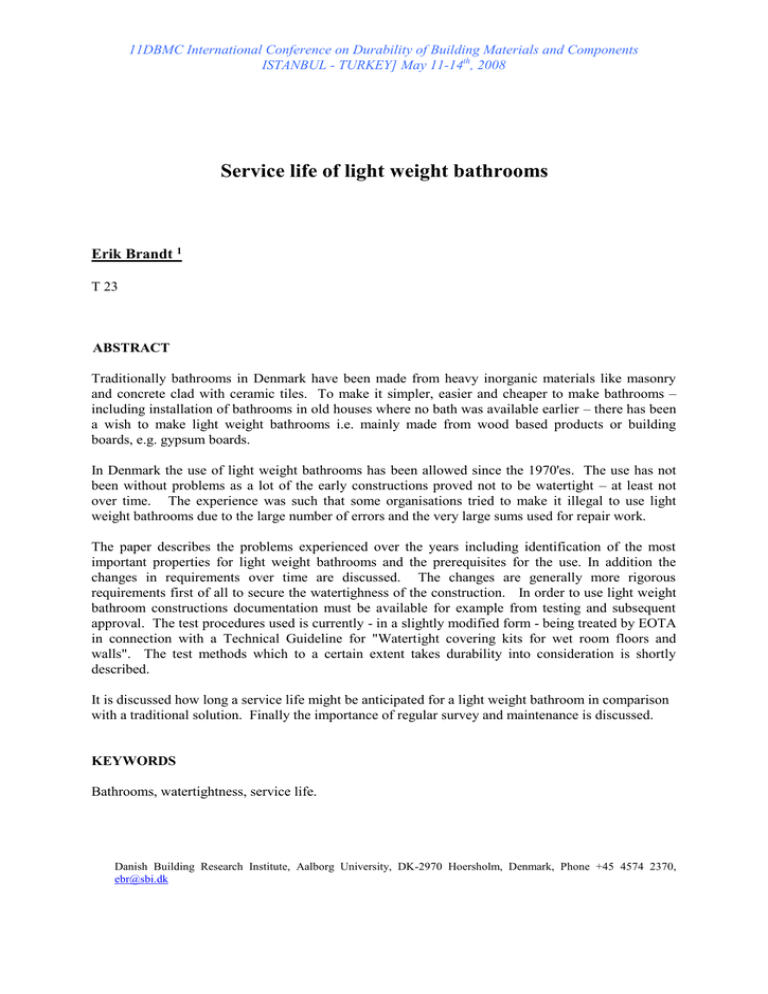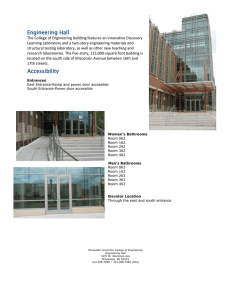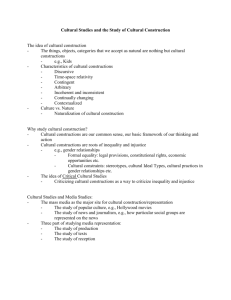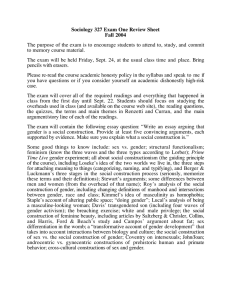Bathrooms 11 DBMC final
advertisement

11DBMC International Conference on Durability of Building Materials and Components ISTANBUL - TURKEY] May 11-14th, 2008 Service life of light weight bathrooms Erik Brandt 1 T 23 ABSTRACT Traditionally bathrooms in Denmark have been made from heavy inorganic materials like masonry and concrete clad with ceramic tiles. To make it simpler, easier and cheaper to make bathrooms – including installation of bathrooms in old houses where no bath was available earlier – there has been a wish to make light weight bathrooms i.e. mainly made from wood based products or building boards, e.g. gypsum boards. In Denmark the use of light weight bathrooms has been allowed since the 1970'es. The use has not been without problems as a lot of the early constructions proved not to be watertight – at least not over time. The experience was such that some organisations tried to make it illegal to use light weight bathrooms due to the large number of errors and the very large sums used for repair work. The paper describes the problems experienced over the years including identification of the most important properties for light weight bathrooms and the prerequisites for the use. In addition the changes in requirements over time are discussed. The changes are generally more rigorous requirements first of all to secure the watertighness of the construction. In order to use light weight bathroom constructions documentation must be available for example from testing and subsequent approval. The test procedures used is currently - in a slightly modified form - being treated by EOTA in connection with a Technical Guideline for "Watertight covering kits for wet room floors and walls". The test methods which to a certain extent takes durability into consideration is shortly described. It is discussed how long a service life might be anticipated for a light weight bathroom in comparison with a traditional solution. Finally the importance of regular survey and maintenance is discussed. KEYWORDS Bathrooms, watertightness, service life. Danish Building Research Institute, Aalborg University, DK-2970 Hoersholm, Denmark, Phone +45 4574 2370, ebr@sbi.dk 11DBMC International Conference on Durability of Building Materials and Components ISTANBUL, Turkey 11-14 May 2008 1 INTRODUCTION In Denmark bathrooms have traditionally been made from heavy inorganic materials e.g. floors of concrete with iron beams and walls made from masonry or concrete. These constructions were considered to be watertight provided that they had a water repellent surface, e.g. ceramic tiles. Different solutions have been invented to install bathrooms in older houses which originally did not have bathrooms. Typically old houses have floor constructions with wooden beams and walls containing wood in some form. The old wooden beams have e.g. been used to support a concrete slab used as floor in the new bathroom. Also lighter construction materials have been used, e.g. wooden studs, plywood or gypsum boards. The advantage is that they are cheap, easy to install and without excess water. The drawback is damages resulting in reduced service life and excessive repair costs. The use of lightweight constructions was introduced in Denmark some 35 years ago. The use has always been restricted to constructions and/or materials either with a national approval for a specific material or construction or approved via directions issued by the Danish Building Research Institute. Experience gathered in the 1990'es, e.g. by the so called “building defects funds”, showed quite a few problems with light weight bathrooms due to insufficient watertightness of the solutions in practice. The problems were almost entirely connected to bad workmanship or use of unsuited materials e.g. watertight membrane was missing or there were failures around details especially floor gullies. As a consequence of the findings a series of changes were made to the requirements for obtaining an approval as well as to the constructions described in the directions from the Building Research Institute with the purpose to improve the service life of the light weight constructions. 2 PERFORMANCE ANALYSIS AND PROPERTIES Before light weight bathroom constructions were allowed in Denmark an analysis was made in order to identify all the functions of bathroom walls and floors and all the agents acting on them. Based on the performance analysis it was possible to set up a list of performance properties for bathroom walls and floors. The five most important properties related to service life are found to be: 2.1 Watertightness Watertightness which is especially required in areas exposed to water. In Denmark the use of bathtubs or shower units is not common and consequently the floor and the walls are directly exposed to water. 2.2 Water vapour permeability In bathrooms a high relative humidity can be expected. This causes a high vapour pressure in the bathroom and consequently diffusion of moisture through floor, ceiling and walls. Especially for constructions that are part of the building envelope it is necessary to take precautions to avoid condensation of moisture inside the structure – this is normally done by the use of a vapour barrier. 2.3 Resistance against mechanical loads The floor and wall constructions in bathrooms shall be able to resist ordinary loads from persons and furniture. This is also the case for vulnerable details like floor gullies and pipe penetrations. T 23, Service life of light weight bathrooms, Erik Brandt 2 11DBMC International Conference on Durability of Building Materials and Components ISTANBUL, Turkey 11-14 May 2008 2.4 Dimensional stability against changes in RH or temperature The constructions must not be damaged by dimensional changes in the materials e.g. due to unavoidable changes in RH due to seasonal variations. For materials where dimensional variations are unavoidable, e.g. wood, precautions must be taken to accommodate the dimensional changes envisaged. 2.5 Compatibility The materials used shall be compatible including materials used for cleaning and maintenance. Besides the above mentioned the bathroom shall ensure that the functions foreseen can take place, for example must the floor be safe to walk on and the surfaces shall be easy to clean. 3 MATERIALS AND CONSTRUCTIONS USED To ensure a satisfying service life the requirements to materials and constructions for bathrooms are generally higher than for ordinary rooms due to the exposure to water: Besides the consequences of failures are most often very severe. For constructions the requirements are expressed as stricter rules regarding strength and stability in order to ensure they are strong and stiff enough to prevent damages to the watertight membrane. Further the materials in the construction should either have small dimensional changes when exposed to variations in relative humidity (unavoidable due to seasonal changes) or measures should be taken to accommodate them. In Denmark it was in the first years required that wood based materials were pressure impregnated in order to make them resistant to water. This requirement was given up after a few years due to a philosophy stating that water shall not be present in the interior of the construction. Surfaces in wet rooms are required to be water repellent or even watertight in order to ensure that water runs of and to avoid ingress of water to any vulnerable materials in the construction. The following is a brief description of materials and constructions used in floor, wall and surface constructions respectively. 3.1 Floor constructions Light weight floors in bathrooms are normally made from board materials supported by wooden beams. The board material may either act directly as sub-floor or as underlay for a levelling compound. To increase the stiffness of the floor compared to ordinary rooms a reduced distance is used between beams/joists. The distance is dependent on the material used and the intended surface material. Boards for floors are most often plywood or chipboard. The latter is nowadays only allowed for resilient floor coverings due to insufficient dimensional stability. Other materials used are polystyrene (PS) boards with a facing or wood based boards with a coating to make them inherently watertight. For inherently watertight boards it is in addition to the watertightness of the board itself required that the joints are watertight. PS boards and gypsum boards are only allowed with a national approval and they both have special requirements to the underlay to ensure a sufficient strength and stability. Service life for light weight floors is good as regards resistance against mechanical loads and dimensional stability. There are only few examples on insufficient stiffness and this has especially been in connection with a change from PVC floor covering to ceramic tiles where the requirements are higher. Problems with floors are usually connected with watertightness. 3.2 Wall constructions For walls there have earlier been problems with insufficient stability. This has resulted in increased requirements to stiffness which may be fulfilled by a combination of 1) reduced distance between T 23, Service life of light weight bathrooms, Erik Brandt 3 11DBMC International Conference on Durability of Building Materials and Components ISTANBUL, Turkey 11-14 May 2008 studs, 2) greater dimensions of studs (the standard is now a 70 mm stud - i.e. a 70 mm cavity in the wall), 3) thicker boards or 4) two layers of boards. Studs may either be wood or steel. Boards come in several materials of which gypsum board are most popular probably due to the price and the fact that they are dimensionally very stable. Due to earlier problems gypsum boards in Denmark now comes as special “wet room boards” with a higher density than normally and with silicone impregnated gypsum. The carton is not impregnated as this would jeopardize later application of watertight membranes etc. Gypsum boards are also available as fibre reinforced boards without carton. Other materials include calcium silicate boards (water resistant) with or without a watertight facing, plywood, chip board and plastic laminate. Finally are used - as for floors - polystyrene (PS) boards with a facing and wood based boards with a coating to make them inherently watertight. The experience with performance and service life for the current constructions are good as regards resistance against mechanical loads and dimensional stability. There have only been a few cases of insufficient stability, e.g. where studs have been cut to make room for pipe penetrations or where walls are not provided with 2 layers of boards. Problems with water tightness are mainly due to lack of watertight membrane or bad detailing. A special problem is seen for walls supplied both with a vapour barrier behind the boards AND a watertight membrane on the face of the board, see below. 3.3 Watertight layer For lightweight constructions it is of utmost importance that vulnerable materials are protected from water and moisture. To ensure watertightness not only the materials but the entire construction including joints, penetrations etc. must be watertight if a long service life shall be achieved. For stud walls protection against moisture is normally achived with a vapour barrier. In bathrooms the watertight layer shall replace the ordinary vapour barrier which consequently shall be left out. If not, water may under unfortunate conditions – e.g. due to an even minor leak – penetrate into the board where it is trapped between the two impermeable layers without possibility to escape. This might lead to accumulation of moisture and severe damages. To day watertightness of a light weight construction is achieved in one of the following ways: o application of a watertight membrane (in fluid form) on the underlay. The membrane is normally protected by a wearing surface most often tiles. In Denmark it is to day a requirement that the membrane shall be at least 1 mm thick. o application of a pre-fabricated membrane. Prefabricated membranes include PVC floor and wall coverings (with welded joints to achieve watertightness). For membranes placed inside the construction all materials over the membrane shall be able to withstand exposure to water. o application of a watertight paint system with a glass fibre cloth as reinforcement. The watertightness is normally achieved by the use of a special adhesive for application of the glass fibre cloth. o inherently watertight boards with watertight joints. Earlier other watertight layers have been used. For example systems based on polyurethane or acrylic materials were used as a combined watertight layer and wearing surface. These systems were used in accordance with national approvals but were given up may be due to problems with crack propagating from the substrate, i.e. insufficient crack bridging ability of the material. Glass fibre reinforced polyester was used to a limited extent but was given up due to safety problems for the workers. For many years all suppliers in Denmark had systems where the watertightness was based on a combination of a primer and a tile adhesive. In principle it is still possible to use such systems provided that watertightness can be documented. However, they are not on the market anymore. Some 12 years ago the building defects funds preferred pre-fabricated membranes because they had seen a lot of problems with fluid applied membranes. This led to a requirement of a minimum 1 mm T 23, Service life of light weight bathrooms, Erik Brandt 4 11DBMC International Conference on Durability of Building Materials and Components ISTANBUL, Turkey 11-14 May 2008 thickness of the fluid applied membranes. This requirement has resulted in a change so to day the fluid applied membranes are the preferred. Both systems have their advantages and drawbacks. A prefabricated membrane has a well defined thickness but may cause problems with the joints especially in the corners. A fluid applied membrane has no problems with joints but may cause problems if the thickness is to low. 4 COMMON FAILURES IN BATHROOMS Failures in bathrooms are generally related to ingress of water or condensation of moisture in the construction. Failures will normally lead to reduced service life and quite often renovation is comprehensive and associated with excessive costs. Failures are seen in all bathrooms including the traditional ones made from concrete, masonry etc. However, the traditional constructions are often more “tolerant” against small failures i.e. the consequences are less severe and renovation not as comprehensive as for light weight constructions. For light weight constructions the most common problems are: o watertight layer/membrane missing or not thick enough resulting in ingress of water in the construction, see figure 1. o lack of detailing for floor gully, pipe penetrations and joints resulting in ingress of water around details, see figure 2. o insufficient stiffness resulting in cracks in tiles – and in some cases damages to the membrane, see figure 3. o insufficient welding of joints in PVC floor and wall coverings resulting in ingress of water through the joints, see figure 4. o illegal changes to floor gully – normally made in connection with renovation of floor where the existing floor gully is extended to a new floor surface. Many problems are seen due to ingress of water through the extensions, see figure 5 and 6. o the bathroom is not designed to resist moisture transport, e.g. vapour barrier is used in connection with watertight membrane or less permeable layers are used inside the construction resulting in accumulation of moisture and deterioration of materials. Besides other problems are seen, e.g. insufficient slope and inaccessible floor gully, which do not have direct influence on the service life. Figure 1. Example of a bathroom wall made from wood based material without a watertight membrane. The lack of watertightness resulted in a total renovation of the bathroom due to fungus and dry-rot in the constructions. Figure 2. Example of pipe penetrations in a floor construction. The tubes (for the pipe in tube system) are finished just over the floor allowing water to run into the construction. T 23, Service life of light weight bathrooms, Erik Brandt 5 11DBMC International Conference on Durability of Building Materials and Components ISTANBUL, Turkey 11-14 May 2008 Figure 3. Example of cracks in a floor with underlay of plywood but with insufficient stiffness. Figure 4. Example of insuffiient welding – worst example ever seen – with repair of the joint with tape. Probably a do-it-yourself work. Figure 5. Example of new floor covering on top of the old. The floor gully has been extended with a plastic frame but unfortunately it is not watertight, see figure 6. Figure 6. The result of lacking watertightness of the extended floor gully is seen as a drop on the water lock (inside the marking) in the flat underneath after floding the floor above under 10 mm water for about 10 minutes. 5 APPROVAL AND TESTING In Denmark the use of new light weight constructions for bathrooms is only allowed with an approval. So far approvals have been national and issued by ETA-Denmark (national approvals are in Denmark designated MK-approval i.e. approval of materials (M) and constructions (K)). Shortly it will also be possible to get European approvals (ETA’s). All approvals are for systems, e.g. a bathroom partition with specified studs, specified boards and specified screws assembled in a specified way. Approvals are issued on basis of a testing. Approval can be obtained for constructions, i.e. floor constructions, or for watertightening systems. Testing of constructions is done in order to ensure that the strength and stiffness is sufficient for use in a bathroom. For example walls are tested according to ETAG 003 (European Technical Guideline for testing of partitions in general and partitions in bathrooms in particular), [EOTA, 2003], with hard and soft body impacts. T 23, Service life of light weight bathrooms, Erik Brandt 6 11DBMC International Conference on Durability of Building Materials and Components ISTANBUL, Turkey 11-14 May 2008 Testing of watertightening systems has until recently mainly been performed according to Nordtest methods, [Nordtest, 1994], [Nordtest, 1991], [Nordtest, 1987]. These methods were developed as a sort of accelerated test methods with exposure to mechanical loads, humidity changes and cycles of hot and cold water. The exposure was chosen to simulate exposure under use conditions but with tougher extremes. The test specimens include all types of details to be expected in bathrooms, e.g. inand outgoing corners, floor gullies and pipe penetrations. The details are included to ensure that not only can they be made in the intended way but they shall also be able to resist in-use conditions under a long period of use. Actually problems most often occur at the details. It can not be said how much the testing accelerates the real life exposure as this very much depend on the actual use. New products appear regularly and even though standard procedures exist for some products these can not always be followed. New products may have properties different from what have been seen earlier and consequently may call for a different test. In such cases it might be necessary to develop new or modified test procedures with the aim of ensuring a sufficient performance and service life. During the past five years an EOTA (European Organisation for Technical Approval) working group has been working on a European Technical Guideline (ETAG 022) for waterproofing of wet rooms. The first part dealing with watertight membranes applied in fluid form is now finished and the remaining two parts (dealing with watertight systems applied as pre-fabricated sheets and inherently watertight boards respectively) are currently under finalisation [EOTA, 2007]. The properties dealt with in the ETAG guideline 022 comprise performance properties as well as properties used for characterisation and production control. The performance properties include, e.g. watertightness, tensile strength (initial and after different exposure conditions), crack bridging ability and water vapour permeability. A number of the test methods in the EOTA work are full scale tests very similar to the NORDTEST methods used in Denmark, Norway and partly in Sweden and Finland until now, i.e. with testing of all relevant details like floor gully and corners. Some of the above mentioned properties are compulsory, whereas others are dependent on national requirements and consequently only need to be documented in the relevant country. For example there are requirements in the Nordic countries (dependent on country) as regards water vapour permeabilty and thickness of membrane. 6 FACTORS AFFECTING THE SERVICE LIFE The service life of light weight bathrooms is dependent on several factors. Besides the factors already mentioned the following should be taken into account: The workmanship is crucial for a good result. Even a good product/system is worth nothing if not installed properly. In Denmark the most common problem is probably that too little watertight membrane is applied. The reasons are believed to be that the membrane is expensive and the application time consuming. This calls for a quality control of the work best performed by the contractor himself and followed up by an independent body. In Denmark a voluntary control scheme has so far only been used for works with PVC floor and wall coverings used as watertight membrane. For PVC works the contractor – actually the individual craftsman – controls his own work and this is followed up by independent surveys of randomly chosen bathrooms. The control scheme has led to a significant improvement of the quality of the work. Maintenance is important and is best performed on basis of regular inspections. Any sign of leakage or potential risk of leakage should be reported and repaired as soon as possible in order to avoid damages. In Denmark light weight bathroom shall be designed so any leakage shows immediately, e.g. by water from a leak dripping out a conspicuous place. Thereby it is possible to make necessary T 23, Service life of light weight bathrooms, Erik Brandt 7 11DBMC International Conference on Durability of Building Materials and Components ISTANBUL, Turkey 11-14 May 2008 repair works before a damage spread out and gives serious and expensive problems in the entire construction. 7 DISCUSSION Light weight bathrooms have now been used in Denmark for more than 30 years. A number of light weight bathrooms have been in use since the use was allowed in the beginning of the 1970’es and still perform well. The increased requirements introduced over the past 12 years have proved to have a good effect as the number of problems has been reduced significantly. Contributing to the reduced number of problems is also that a huge effort to teach consultants and contractors about the importance of good design and workmanship has been fruitful. Today most architects, engineers and craftsmen are very much aware that bathrooms constructions are complicated and require special attention. It is believed that good performing bathrooms with long service lives can be achieved if the earlier mentioned factors affecting the performance and service life are taken into account when designing and executing a light weight bathroom, i.e.: o the bathroom shall be designed taking into account not only the constructions but also the installations and any complications that may arise due to the severe exposure to water and high relative humidity, o floor and wall constructions shall be stable enough to avoid deflections that may damage the watertight layer and the surface covering, o vulnerable materials shall be efficiently protected by a watertight layer, e.g. a membrane. The watertight layer shall be approved for the intended use or sufficient documentation for performance and service life shall be provided by the supplier, o vulnerable materials shall be protected from condensation of humidity, e.g. by a membrane (normally the watertight membrane), o all details shall be well described and tested for watertightness, o design as well as execution shall be under quality control, o the contractor shall be made aware of the importance of good workmanship, o the bathroom shall be maintained regularly preferably on basis of regular inspections. Based on the experience gained after the implementation of the stricter requirements it is assessed that light weight bathrooms are able to function properly. On condition that the above mentioned requirements are met it is assessed that light weight bathroom have service lives of 30 years or more. REFERENCES [EOTA, ETAG 003, "Guideline for European Technical Approval: Internal partition kits for use as non-loadbearing walls", 2003]. [EOTA, ETAG 022, "Guideline for European Technical Approval: Watertight covering kits for wetroom flors and/or walls", Part 1 "Liquid applied membranes", 2007]. [Nordtest Method 230, "Bathroom floors - watertightness", 1994] [Nordtest Method 058, "Bathroom Walls: Watertightness and Resistance to Water and Moisture", 1987] [Nordtest Method 389, "Wall coverings: Waterproofing on small test pieces", 1991] T 23, Service life of light weight bathrooms, Erik Brandt 8




